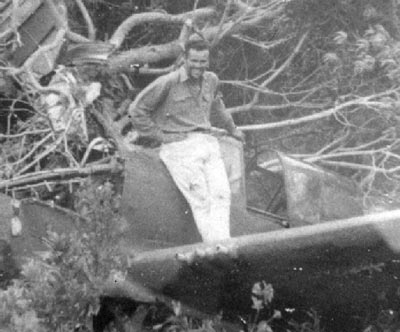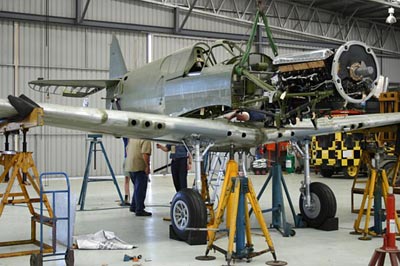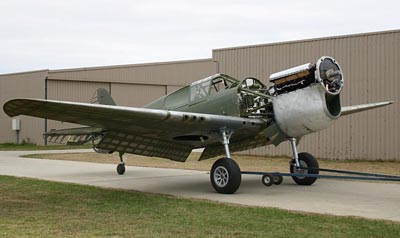|
|
|
|
| Missing In Action (MIA) | Prisoners Of War (POW) | Unexploded Ordnance (UXO) |
| Chronology | Locations | Aircraft | Ships | Submit Info | How You Can Help | Donate |
|
| USAAF 13th AF 18th FG 44th FS  USAAF December 20, 1942   via Pioneer Aero |
Pilot 2nd Lt. C. B. Head, Jr. (survived) Force Landed December 20, 1942 MACR none Aircraft History Built by Curtiss as a model H87-B3 in Buffalo, New York during 1941. This aircraft was the 513 of 699 P-40Fs powered by a Rolls Royce Merlin engine with a shorter fuselage. Delivered to the U.S. Army Air Force (USAAF) as P-40F Warhawk serial number 41-14112. Disassembled and shipped overseas to the South Pacific then reassembled. Disassembled and loaded as cargo aboard USS Nassau (CVE-16) across the Pacific to New Hebrides then reassembled. Wartime History Assigned to the 13th Air Force (13th AF), 18th Fighter Group (18th FG), 44th Fighter Squadron "Vampire Squadron" (44th FS). Nicknamed "Pee Wee" assigned to flight leader Captain Sam Hitchcock (who was on Oahu during the Japanese attack on December 7, 1941). Other pilots known to have flown this P-40 include Captain Elmer 'Doc' Wheadon. Mission History On December 20, 1942 took off from Bauerfield Airfield on Efaté piloted by 2nd Lt. C. B. Head, Jr. as one of four P-40s on a training and navigation mission. The other aircraft in the formation were flight leader P-40 piloted by 1st Lt John E. Little, P-40 piloted by 2nd Lt Frank Radzuikinas, P-40F "Bone Crusher" 41-14205 plus this aircraft. Thirty minutes into the mission, the formation encountered severe weather and ran short on fuel. The four P-40s force landed in a clearing atop Mount Santop on Erromango. All four pilots were unhurt in the landings. The two aircraft piloted by Little and Radzuikinas belly landed successfully. During the landing, this P-40 and P-40F "Bone Crusher" 41-14205 went over an embankment and were badly damaged. Wreckage Afterwards, Americans cleared a path to the aircraft and stripped them for parts. Over the years, more parts were removed, including the fuselage star, cut out of the side fuselage. This P-40 remained in situ until November 1989. Salvage During November 1989, Robert Greinert, Ian Whitney and Martin Mednis salvaged this aircraft and P-40F "Bone Crasher" 41-14205 (along with parts from two others). Both planes were placed into a container and shipped to Australia. Peninsula Aero Club - Warhawk Restoration by Judy Pay "In 1989, I decided that, with the price of rare warbirds increasing rapidly, and as these were the only known Merlin powered P-40s ever found, it would be worth trying to get the aircraft. I traveled to Vanuatu only to find that an Australian group had arrived four weeks earlier and that the P-40s were on the wharf, ready to be shipped to Australia." Restoration Purchased by Australian Judith E. Pay and first registered in Australia on July 30, 1995 as VH-HWK. During 1990, restoration began. During 1990, Pioneer Aero Restoration began restoring the fuselage, tail, engine and wings. Afterwards returned to Old Aeroplane Company at Tyabb. Restored to flying status with its first flight on April 22, 2009 piloted by Stephen Death. References Peninsula Aero Club - Warhawk Restoration by Judy Pay Pioneer Aero P-40 Kittyhawk 42-14112 Australian Civil Aviation Safety Authority (CASA) - Curtiss P-40F Warhawk 41-14112 VH-HWK Contribute Information Are you a relative or associated with any person mentioned? Do you have photos or additional information to add? Last Updated
|
P-40 Photo Archive |
| Discussion Forum | Daily Updates | Reviews | Museums | Interviews & Oral Histories |
|